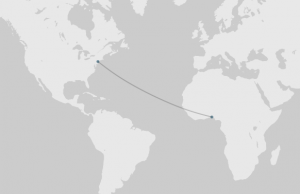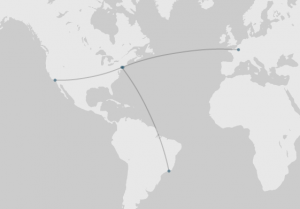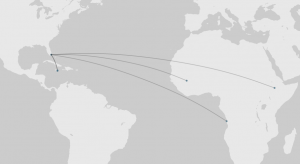In his sixth studio album God’s Son, rapper Nas (born Nasir bin Olu Dara Jones) did something that few American hip-hop artists have done. He sampled an African song for the opening vocals and primary bass line for“Warrior Song,” the eleventh of fourteen tracks. The song also featured a hook by Alicia Keys whose lyrics imply this that the track is an exhortation to those who struggle to stay strong and to maintain their individuality.
“This is a song, for my warriors (A warrior song)
Bravehearted and strong, definition of a warrior (Definition of a warrior)
Gonna keep marchin on, to the sound of my own beatin’ drum”
However, analyzing the song’s three verses suggest less of statement of solidarity with warriors to an imagined enemy than as a message of defiance. Nas’s claims about his opponents, that “They can’t break me or shake me/They too fake to come kill me” suggests that a warrior is one who simply survives what the world throws at them. A warrior is made by the endurance of tribulations, not of the defeat of enemies. This theme of survival comes up again later with the couplet: “Middle Passage I made it/I’m from the land of David” outlining the sanctity of the site of Nas’s origin and the survival of terror that is implied by him living in the present. The second verse is also an emotional reflection on the death of Nas’s mother, implying that the warrior is not just one who battles physical attacks, but who weathers emotional and psychological violence. But what is most striking in Nas’s track from the standpoint of sound is his choice of samples.

What makes “Warrior Song” unique is that kicks off not with an obscure break from American Funk or Soul, but with a sample from the Nigerian Afrobeat artist, Fela Kuti. The track, a 1975 recording of “Na Poi”, is markedly different from much of what Nas has sampled in his previous efforts. The song itself is one of Fela’s less famous tracks, though it was banned by the Nigerian Broadcasting Company in 1972 (the song was originally recorded and released in 1970). “Na Poi” was one of the already controversial Fela’s more confrontational songs, though its politics were of a personal and sexual nature. Composed of extended drum breaks, solos, and rhythmic chanting, “Na Poi” is a explicit depiction of sexual activity which reflected the spirit of the artist’s infamous Kalakuta Republic compound in the late 1960s. The censorship was also brought about by Fela’s claims of sovereignty over his home and recording studio. The military government which ruled Nigeria at the time first censored his music and later attacking the compound with a company of soldiers and burning it to the ground.
Even today, with hip-hop’s increasing importance to culture in Africa, Europe, and South America, it is rare for an American hip-hop artist to sample non-American music and it is rarer still for a mainstream artist such as Nas to sample modern African music. While there is little in “Na Poi” that literally relates to the themes of “Warrior Song,” the use of Fela’s voice and bass line suggest that the artist himself is another warrior who danced marched to the sound of his own drum. Nas’s choice also reflects a re-emergence of Afrocentric themes in hip-hop in recent years, but these ideas have been an important aspect of various sub-genres of hip-hop since the early 1980s. However, the practice of sampling African music in the construction of hip-hop track in 2002 suggests a shift in the trajectory of samples in the Black Atlantic.
As discussed in the previous sections, in spite of the global reach of modern hip-hop, its production has until recently followed several tropes when it comes to the types sounds that form the basis individual tracks. Funk, R&B, soul, and jazz from the United States has long been standard, even in hip-hop from nations as diverse as Poland, Japan, France, and Brazil. Sampling Fela in 2002 was concurrent with the rediscovery of Fela Kuti’s life and music and also reflected an effort by Nas to connect his music to something larger than many of the themes he rapped about on his earlier efforts, such as the acclaimed 1994 record Illmatic, the follow-up It was Written, and Stillmatic in 2001. This would become apparent in his 2010 collaboration with Damien “Jr. Gong” Marley, Distant Relations, but the theme of Afrocentric outlooks in hip-hop has a much deeper history, as does the practice of looking outside of the United States for samples.
Afrika Bambaataa, one of the pioneers of hip-hop, was one of the first DJs to look for samples outside of African-American musical traditions. Bambaataa, born Kevin Donovan, was raised in the South Bronx. As Jeff Chang recounts in Can’t Stop, Won’t Stop, Bambaataa ran with the youth street gang the Black Spades. But as the 1970s began, the old structure of the youth gangs was following apart. Bambaataa began to unite different gangs in a peaceful organization that he dubbed the Zulu Nation. He used the shared African heritage of his fellow Puerto Ricans, Jamaicans, Bajans, and African-Americans to unite kids and encourage them to dance and play music instead of fight. Bambaataa, also known as “Bam,” had charisma and an abiding interest in African resistance. He cited the viewing of the 1964 Cy Endfield historical drama Zulu as influential to his sense of community and sense of self. The movie “just blew my mind,” Bam told Chang, “To see these Black people fight for their freedom and their land just stuck in my mind. I said when I got older I’m gonna have me a group called the Zulu Nation.”[1] Bambaataa’s mission, to unite the young disaffected men from the “necropolis” known as the South Bronx was best achieved, in his mind, through music and the construction of community.
Bambaataa’s parties became legendary and in doing so he helped calm tensions between the gangs. His breadth of knowledge about music is indicative in his influential 1982 track “Planet Rock.” Sampling Kraftwerk (both 1977’s Trans-Europe Express and 1981’s Computer World) and the band Babe Ruth brought together two very distinct sounds, experimental electronic music and more traditional rock ‘n roll. The German group Kraftwerk were also pioneers in electronic music, utilizing instruments like the Moog Synthesizer and early drum machines to create early music without familiar instruments. In addition to Kraftwerk and Babe Ruth, Bambaataa used a famous early computer-generated sample known as ORCH5, short for Orchestra 5. That sample was based, according to some musicologists, on the first note from Stravinsky’s Firebird Suite, to punctuate the track throughout.[2] ORCH5, played on an early digital sampler, the Fairlight CMI.

As the map shows, “Planet Rock” is built from samples recorded in London and Dusseldorf, arriving in New York and sampled for Bambaataa’s composition. “Planet Rock” is the exception that proves the “rules” outlined in the two previous sections, that hip-hop is largely constructed from mid-century and recent American music. Additionally, “Planet Rock” challenges assumptions about the essential nature of hip-hop—as the result of sampling certain kinds of African-American music—and is also an early example of the internationalization of hip-hop as an art form. However, few American artists followed in Bambaataa’s footsteps in the decades that followed.

As this map indicates, “Planet Rock” has become influential in other hip-hop and musical genres. Proyecto Uno, an American-based Dominican hip-hop group has used the track in their recent “El Party” track. Brazilian producer Fabio “Fabinho” Silva incorporated important elements of Bambaataa’s vocals into “Planeta Dominada” a Brazilian Funk track in 1999. And, most recently, Anita Tijoux, the Chilean-born French hip-hop MC, rapped over a sample of “Planet Rock” on her 2011 mixtape Elefant. “Planet Rock” remains heavily sampled in the United States as well with some 80 samples listed on WhoSampled. It primarily sampled in other hip-hop tracks, but it also remains popular in electronic music. As hip-hop becomes a driving force in music scenes around the world, how have American artists responded? How has music from Mali, Angola, Nigeria, and Ghana (to nam e a few examples) been represented? How have those artists been involved in the production and distribution of their own music?
One way that African, Latin American, Asian, and other music of the Global South has become more familiar to North Americans has been the growth of the “World Music” genre. The genres of “World Music” or “Worldbeat” arose in the 1970s and 1980s have long been tinged with a patina of appropriation. Labels like Putumayo World Music, based in New York, have produced compilations titled “African Beats” or “Latin Beats” that take musical selections from throughout these regions and place them together on an album to sell in North American and European record stores. On the one hand, these compilations have brought attention to music scenes in Cuba, Mali, South Africa, and Ecuador from acclaimed musicians like Ry Cooder, Peter Gabriel, or Paul Simon.
On the other hand, there are important questions about how artists that are featured on these compilations are being compensated for their work and the way in which their work is being presented. Additionally, “World Music” as a genre also helps reinscribe otherness and difference into musical production, exoticizing musical forms that are important to hundreds of thousands (if not millions) of people. But what is different about sampling a Nigerian Afrobeat tune or Algerian Raï for a North American hip-hop release? What about artists that incorporate traditional instruments like the West African djembe, the Sahelian ngoni, and the Brazilian cuica into music that does not have a connection to the history of those pieces?
While hip-hop does often obscure context and obfuscate ownership in the finished track, the holistic inclusion of the artist’s original work suggests that there is greater acknowledgement of the importance of the original artist. Richard Schur argues that “Hip hop emphasizes and calls attention to its layered nature. The aesthetic code of hip hop does not seek to render invisible the layers of samples, sounds, references, images, and metaphors.” Instead, producers and artists “[aim] to create a collage in which the sampled texts augment and deepen the song/book/art’s meaning to those who can decode the layers of meaning. ”[3] In other words, whereas asking Soweto singers to provide backup to a musician’s own arrangement subsumes their creative addition beneath the composer’s own artistic vision, hip-hop producers have to contend with a sample on its own terms. The result is that tracks are built around a given sample in such a way that highlights what makes it unique in the first place.
Nas’s “Warrior Song,” foreshadow’s the artist’s recent collaboration with Damien “Jr. Gong” Marley. Distant Relatives, their 2010 collaboration, samples a variety of tracks from both the Caribbean and Africa. While most of the former are concentrated in Kingston Jamaica, as this map indicates, the African tracks originate in the historical and musical contexts of Angola, Mali, and Ethiopia.

Distant Relatives, recorded primarily in Miami, utilizes a host of samples drawn from Africa and the Caribbean. While all of these areas have a history of colonialism, three of the African samples were recorded during the era of colonization (or immediately thereafter) and speak directly to decolonial struggles. “Friends,” the fifth track on the album begins with a sample from David Zé’s “Undenge Uami.” Zé an Angolan revolutionary poet and soldier was born David Gabriel José Ferreira in Luanda in 1944. In the mid-1960s, Zé he joined Agostinho Neto’s Popular Movement for the Liberation of Angola (MPLA). Between 1965 and his death in 1977, he recorded and released sixteen singles and a full album, which was released in 1975 just after independence. This album, Viuva da Liberdade (“Widow of Liberty”) is a melding of Umbundu, Portuguese, and Reggae lyrics and sounds so that Zé can mourn the plight of Angola and celebrate its resistance to Portuguese rule. As one sympathetic biographer put it, Zé became “mythic voice of colonial resistance in Angola.”[3]
Despite the MPLA’s triumph over the Portuguese in 1975, conflicts between the MPLA and two other rebel groups–Holden Roberto’s anti-Communist National Liberation Front of Angola (FNLA) and Jonas Savimbi’s National Union for the Total Independence of Angola (UNITA)–continued the fight until the 1990s. During one clash in 1977, Zé was killed, apparently in an assassination attempt on another MPLA official. Zé’s work, though celebrated in Angola and known in Brazil, remained obscure in the Caribbean and North America. Another Angolan artist sampled by Jr. Gong and Nas was far more well-known, but her reputation has shaped how she is remembered.
Sara Chaves, who is sampled on the tenth track, “Nah Mean,” was born on the Southern bank of the Kongo River in the town of Soyo. Until she was an adult, Chaves thought that she was the daughter of two Portuguese colonial officials and it was only when a half-brother tracked her down that she discovered her true parentage. Her father had been a Portuguese soldier and her mother was an Angolan woman. Through her half-brother, she connected with her mother’s family and found new connections to the nation she was raised in.
In the meantime, she had become well-known as a famous singer in Angola and Portugal, singing primarily in Portuguese. As resistance to Portuguese rule grew, Chaves threw her support behind Neto’s MPLA and recorded songs, gave concerts, and took on a role of public international activism on their behalf. Her public reputation was damaged in Portugal and she had to flee Angola due to threats of violence from the colonial regime. The track that is used by Marley and Nas, Kurikuté, features Chaves singing over the sounds of African drumming and a male chorus in both Umbundu as well as Portuguese, reflecting on her Angolan heritage and emphasizing her connection to her homeland. Following Neto’s victory, Chaves was invited back to Angola where she continued to perform until her death, celebrated by the MPLA regime for her commitment to their struggle.
The third sample from Africa that Jr. Gong and Nas chose was “Yegelle Tezeta” by the Ethiopian jazz musician Mulatu Astatke. Astatke, also known as Astaque, was born in Ethiopia but studied music in the United States. While in New York at the Berklee School of Music, he encountered American and Latin Jazz and combined those forms with Amaharic musical traditions to create what he dubbed “Ethio-Jazz.” Astatke returned to Ethiopia in the late 1960s and began producing music until he was forced to leave Ethiopia in 1977 by the forces of Mengistu, who had forced out emperor Haile Selassie in a bloody coup in 1975.
Chaves, Zé, and Astatke spoke out against the lasting influence of colonialism and of their frustration with dictatorship. The use of their samples on Distant Relatives emphatically links their stories with ideals expressed by Marley and Nas: brotherhood, unity, and solidarity amongst people of color across national boundaries and oceans. Forging these connections lyrically and musically helps draw people together and mapping their connection highlights important changes within the practice of sampling.
How to cite this page: Romine, David T., “A Sonic Map of the Black Atlantic” Deeps, The Black Atlantic, Duke University, http://sites.duke.edu/blackatlantic/ (accessed on (date)).
I appreciate you sharing this awesome page. It’s seriously helped me.